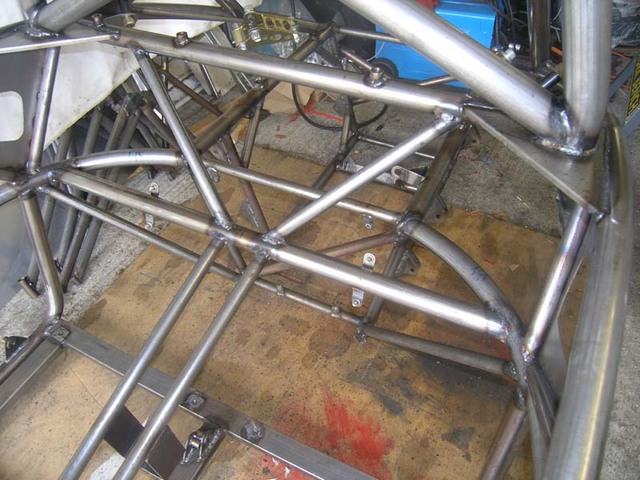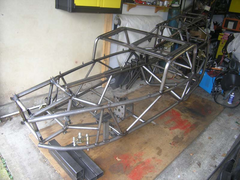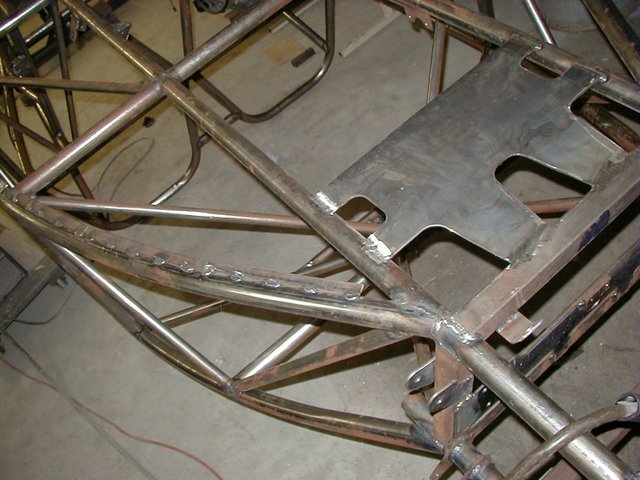Alan B
|
| posted on 21/4/08 at 02:05 PM |

|
|
Chassis tubes and rivets
I'm trying to asses opinion here about the downsides of drilling and rivetting into chassis tubes.
Personally, I hate the thought of it from a structural point of view......yet, it's very common practice and I can't say I've ever
heard of a structural failure because of it.
It would save me a lot of extra brackets and tabs if I could convince myself or be convinced that it was an OK thing to do....
Your views?
|
|
|
|
|
Mr Whippy
|
| posted on 21/4/08 at 02:14 PM |

|
|
It's a very good question whether strength is being added or removed. One way to look at it is that the panel is usually adding support to the
tube and preventing it buckling. Though turning it into a Swiss cheese by over riveting a flimsy piece of ally might do more harm than good. I donít
know of any hard and fast rule.
Fame is when your old car is plastered all over the internet
|
|
|
nitram38
|
| posted on 21/4/08 at 02:32 PM |

|
|
Alan, I have welded short tags to my chassis with captive rivnuts to attach my panels.
On our cars where we have curved main rails, we have already made a compromise on strength because of the curve.
For that reason, I haven't put any holes in my curved tubes.
Rolling a tube creates thinner wall thickness due to stretching.
You can see the tags in these photos:
 
Description
 
Description
[Edited on 21/4/2008 by nitram38]

|
|
|
nick205
|
| posted on 21/4/08 at 02:34 PM |

|
|
Why not bond the panels in place with structural adhesives?
No tabs and fixings required and no rivet holes required.
It may take greater design/manufacturing effort to ensure that the chassis and panels are suitable for bonding, but having seen you're efforts
so far I'm sure it's within your capability!
|
|
|
DaveFJ
|
| posted on 21/4/08 at 02:47 PM |

|
|
I think it depends on how close together the rivets are and what type you use...
Do you intend the ally sheet to peform a structural role?
Just think about aircraft structures and you soon ses that riveting can't be that bad!
personally I would (and have) use structural rivets and bond with PU adhesive. they aren't cheap but they are soo much better than the usual
tucker pops people use.
I used Huck Magnaloks...
Dave
"In Support of Help the Heroes" - Always
|
|
|
smart51
|
| posted on 21/4/08 at 02:51 PM |

|
|
I've welded tabs onto mychassis with holes predrilled for fixing brake pipes, throttle cables, pedal boxes, fluid reservoirs, battery
boxes...
I don't like the idea of drilling holes in tubes. As well as strength, it is a way for water to get in and rust to spread. My car will be a
drivable chassis even with no bodywork fitted whereas my seven has stuff riveted to all the aluminium panels.
Adhesives are great until they start to peel. You need rivets or bolts at least in the corners to stop a peel starting.
|
|
|
Bluemoon
|
| posted on 21/4/08 at 02:52 PM |

|
|
I doubt rivet holes are a problem, after all the percentage of tube removed is very small compared with what is left.
Planes are riveted at a spacing of 8 times the rivet diameter. These joints are structural. They don't have a structural problem with this,
quite the opposite.
Rivnut holes might be a different matter as these can get rather big.
I would personally weld as many fixtures on as you can, then rivet panels+structural adhesive. Decent rivets will help, have a chat to primary
fastness.
As David said "structural" rivets are best. But you will need a special setting tool, and the rivets are not cheap. I chose a not
structural quality "multi grip" rivet in the end for my MK as a compromise.
For panels that are structural (floor? bulked behind seats?) I would consider 8d rivet spacing. This might add stiffness to the design.
I would think if your chassis is designed well it should be stiff enough without the panels though (from a safety perspective). So I would view any
addition possible extra stiffness as a way of improving road handling.
I guess if you are using round tubes fixing the panels might be less structural than using round ones mind, as it might be difficult to fix the panels
well??
Dan
[Edited on 21/4/08 by Bluemoon]
|
|
|
Alan B
|
| posted on 21/4/08 at 03:06 PM |

|
|
Hmmm....excellent well considered feedback.
Is it any wonder that this is probably the best car building forum in the world.
Up to now I do have brackets for most stuff and things without brackets will be clamped to tubes rather than drilled...so it's really the floor
and rear bulkhead I'm considering neither of which are structural...
Martin, what kind of spacing are you using for your fasteners?....I'm guessing 8d is not required for non-structural applications?
|
|
|
nitram38
|
| posted on 21/4/08 at 03:59 PM |

|
|
Alan the spacing is not an exact science because my floor is not structural.
My seats are supported in a steel tube frame.
I just took a rough guess at the spacing, just enough to hold the weight of the floor tub.
With my air suspension, the tub will be on the ground when I get in or out so it will literally be holding the weight of my legs when driving.

|
|
|
speedyxjs
|
| posted on 21/4/08 at 04:03 PM |

|
|
quote:
Originally posted by Alan B
Is it any wonder that this is probably the best car building forum in the world.
What do you mean probably? IT IS!!! 
How long can i resist the temptation to drop a V8 in?
|
|
|
Fozzie
|
| posted on 21/4/08 at 04:13 PM |

|
|
Hmmm it seems as though there are a lot of differing opinions here! 
My tuppence worth........
if you think about all of the rivets into your chassis.....(I'm talking 'close' riveting here)...... mentally take that ali panel
away and what do you see?........loads of holes in your chassis that, if too many rivets are used, almost slits that chassis rail along the horizontal
or even the vertical... 
Along with many areas for water/damp to get in.......
Assuming a steel chassis and ali panels.......you then have the old problem of 2 metals that really do not like each other........
so which type of rivets do you use?.....before you all shout...I have very few rivets.....about 6 and none actually in the chassis.....and none of my
panels touch the chassis.....they are 'lined' where they meet...... and yes, I have used other fixings, but again they are buffered with
either fibre or nylon washers! so nothing actually touches!
So ok you decide to go with it anyway.....what is the scenario should you need to remove/replace any of the ali panels for either access or
replacement?
......what would that do to your chassis?
As said.....just my 2p's worth and all IMHO...
Fozzie 
'Racing is Life!...anything before or after is just waiting'....Steve McQueen

|
|
|
MikeR
|
| posted on 21/4/08 at 04:45 PM |

|
|
i've asked you this before and i've got to ask again ....
where are the 6 rivets???
I'm rapidly approaching this stage and i've never liked the idea of drilling lots of holes for rivets. Just seems wrong. I'm
starting more and more to like either the welded tabs / floor idea or glued panels.
(then again i think the race car's produced by Matt look damned sexy)
|
|
|
procomp
|
| posted on 21/4/08 at 06:53 PM |

|
|
Hi put it this way i would not be doing it unless it had superior benefits. And they have been proved with the rigidity of a chassis tested.
It's all a case of how you go about doing the job. As with any job if you do a crap job you get crap results. It takes a lot of time to do the
job properly and an awful lot of effort. But certainly worth it when done properly and using the correct products ie alloy - rivets and sealant. If
you are just using a soft alloy cheap rivets and bathroom sealant it's just not going to work.
Cheers Matt
|
|
|
caber
|
| posted on 21/4/08 at 07:43 PM |

|
|
Reminds me of an old story from the aviation industry. They were testing an airframe in a wind tunnel and they kept having problems with the wings
ripping off along the wing root. After this problem had been back to the design office several times without success the management were getting
desperate. They decided to open the problem up to the entire workforce and set up a suggestion box. After a week they opened the box to find only one
suggestion-: "drill a series of holes along the line where the wings rip off". The suggestion was unsigned and given to the design office.
As they had tried their best and not managed to get it to work they thought nothing was to be lost in trying the idea out, so another model was made
and they carefully drilled holes exactly along the line where the wings had torn off in previous tests. They put the model in the wind tunnel slowly
increased the speed, at last success! the wings did not tear off. They presented the results to the management who were very relieved however the MD
said" You guys are the highest paid people in the damn company, whoever came up with this must a genius! He must be found and promoted!"
So a sign was put up asking for the person who submitted the idea to visit the Managing Director's office.
The following day the toilet attendant arrived to speak to the MD "Guv, it was me what put the suggestion in"
"You! how can a toilet attendant have solved our most difficult structural design problem?"
"Easy Guv toilet paper never tears along the perforations!
Caber
 
|
|
|
MikeR
|
| posted on 21/4/08 at 08:14 PM |

|
|
quote:
Originally posted by procomp
Hi put it this way i would not be doing it unless it had superior benefits. And they have been proved with the rigidity of a chassis tested.
[bits removed]
Cheers Matt
I should qualify my "wrong" answer. I know why you do it and appreciate the benefits. I'm still tempted but my car is definately a
road car and the less holes i put in the chassis the longer it will last (in my mind due to less chance of rusting / water ingress) hence the comment
about being wrong. On the other hand i think your car looks great - so thats part of the dilema (and i would be doing it on the cheap so it
wouldn't get the benefit .... perhaps i should hunt out stick on rivet heads to get the look without the benefit  ) )
|
|
|
vinnievector
|
| posted on 22/4/08 at 10:01 PM |

|
|
fretting a littel
i think you guys are fretting just a little hear as your chassis is more than adequate in strength to have a few holes in ,if you plan to pitch your
rivets less than an inch apart you may start to have some structural lose but i doubt that you would want to put as many holes in your Cassie 3 to 4
inch spacings are good this will give you some structural strength to the chassis also tempered alloy sheet is best t3 alclad if you can afford it 1mm
or 42 thou see if you can get hold of a two part mix sealant like pr1422 see air craft supplies on the web pages and use cherry max rivets 5/32 alu
uni head you can pull these with normal pop pliers any bigger your pop pliers will not pull them see cherry max web site for info on length and how
they are constructed as it would take me a while to explain how they work , hope this helps
|
|
|
nitram38
|
| posted on 22/4/08 at 10:11 PM |

|
|
It might be ok on straight rails but I am not sure about curved ones.
Both mine and Alan's car have rolled tubes which because of the rolling process will be thinner on the outside edge.
Putting holes in main structure curved rails is not a good idea in my opinion.
They are already slightly weaker than a straight rail and putting a hole in it might cause some places where fractures will start to appear.
I got a mate to cnc me some tags and I put rivnuts in them and welded them on.
If there is any doubt about strength, why not just spend a bit more time doing this way?
One advantage is the ability to remove panels easily, especially if they get damaged.

|
|
|
Alan B
|
| posted on 22/4/08 at 10:21 PM |

|
|
Martin, that is pretty much what I'm going to do. I'm welding pieces of 3/4" x 1/8" strip all round then I'll tap holes
and use #10-32 (about 5mm) stainless button heads....the same way I fastened my buggy floor and panels on.
Thanks all for your input.
|
|
|
nitram38
|
| posted on 22/4/08 at 10:26 PM |

|
|
Alan hopefully I will see them when we pop in on 28th August! 
The day before, I have booked a Balloon flight over Orlando.
That's how I got hooked on motor racing. I just booked a one day single seater and a year later I was doing club racing!

|
|
|
vinnievector
|
| posted on 22/4/08 at 10:40 PM |

|
|
don't disagree ,think i would go down the same path with the tabs, i would recommend useing nut plates rather than tapping your hole ,as the
plates come with a stiff nut which will stop the screw coming lose stronger centre less able to strip the thread.
|
|
|
StuartBJ
|
| posted on 22/4/08 at 10:58 PM |

|
|
Materials Engineering at it`s finest 
Optionss
1) drill chassis, bond and rivet
Advtages = Adds greater rigidity (possibly)
Disadvanatges = Possible reduction in fatigue life of chassis, increased corrosion potential (galavanic cell established)
2) weld tabs
advantages = chassis untouched (only the welding will cause a heat effected zone).
Disadvantages = possibly awkward to do at this stage of your build, requires the ability to weld etc do you own a welder?
3 Bond only
Adv = Chassis completely untouched, no heat effected zones, no holes in chassis, corrosion potential not as adverse as riveting, cheap, can be as
effective as riveting alone.
Disad = not as realistically as tructural as the previous two options.
|
|
|
kb58
|
| posted on 22/4/08 at 11:40 PM |

|
|
Some bonding compounds are dissolved by gas, oil, coolant, brake fluid, etc. It's not wise to count on the adhesive alone so some rivets are
still a good idea.
Mid-engine Locost - http://www.midlana.com
And the book - http://www.lulu.com/shop/kurt-bilinski/midlana/paperback/product-21330662.html
Kimini - a tube-frame, carbon shell, Honda Prelude VTEC mid-engine Mini: http://www.kimini.com
And its book -
http://www.lulu.com/shop/kurt-bilinski/kimini-how-to-design-and-build-a-mid-engine-sports-car-from-scratch/paperback/product-4858803.html
|
|
|
Alan B
|
| posted on 22/4/08 at 11:45 PM |

|
|
This is what I'm doing...not super elegant but it will work...
 
Frame03
|
|
|
Fozzie
|
| posted on 22/4/08 at 11:52 PM |

|
|
SNAP....'ish' ...... 
        
Fozzie  
[Edited on 23-4-08 by Fozzie]
'Racing is Life!...anything before or after is just waiting'....Steve McQueen

|
|
|
nitram38
|
| posted on 23/4/08 at 07:20 AM |

|
|
That is a good idea Alan.
The rib will add stifness to the chassis (in one plane at least) and spread the load of any fixing!

|
|
|









